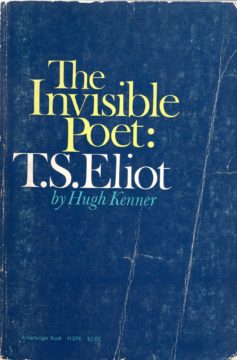Todd Cronan at nonsite:
 According to Kenner, the Hollow Men provides the first expression of the “structural principle” of Eliot’s later work and, I would suggest, of Kenner’s work as well. What is that principle? Eliot’s aim is to articulate “moral states which to an external observer are indistinguishable from one another” (IP, 163). So that we can “judge a man’s action,” Kenner says, but “we cannot judge the man by his actions.” What Kenner calls “distinct actions,” occlude from the observer the nature of a man’s true actions. And since what we are asked to judge are “moral states,” it naturally follows that we are not meant to judge works of art, which is exactly what Kenner says (IP, 163). “In art,” Kenner writes, “actions are determined by their objects.” In morals, by contrast, actions are “determined by their motives, which are hidden: hidden, often, from the actor” (IP, 163). The art that Kenner admires is anti-art in the sense that conventional artworks are construed as the expression of distinct actions, a kind of action we sometimes define as intentional tout court.
According to Kenner, the Hollow Men provides the first expression of the “structural principle” of Eliot’s later work and, I would suggest, of Kenner’s work as well. What is that principle? Eliot’s aim is to articulate “moral states which to an external observer are indistinguishable from one another” (IP, 163). So that we can “judge a man’s action,” Kenner says, but “we cannot judge the man by his actions.” What Kenner calls “distinct actions,” occlude from the observer the nature of a man’s true actions. And since what we are asked to judge are “moral states,” it naturally follows that we are not meant to judge works of art, which is exactly what Kenner says (IP, 163). “In art,” Kenner writes, “actions are determined by their objects.” In morals, by contrast, actions are “determined by their motives, which are hidden: hidden, often, from the actor” (IP, 163). The art that Kenner admires is anti-art in the sense that conventional artworks are construed as the expression of distinct actions, a kind of action we sometimes define as intentional tout court.
more here.
